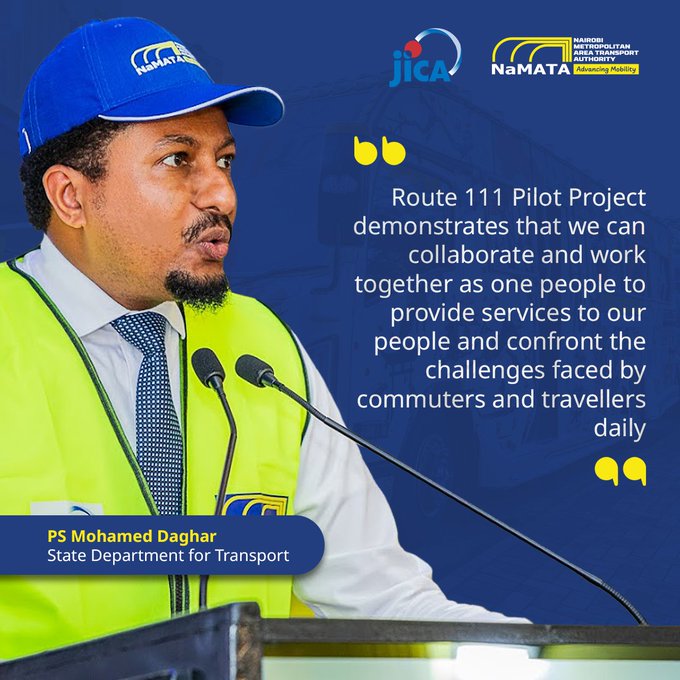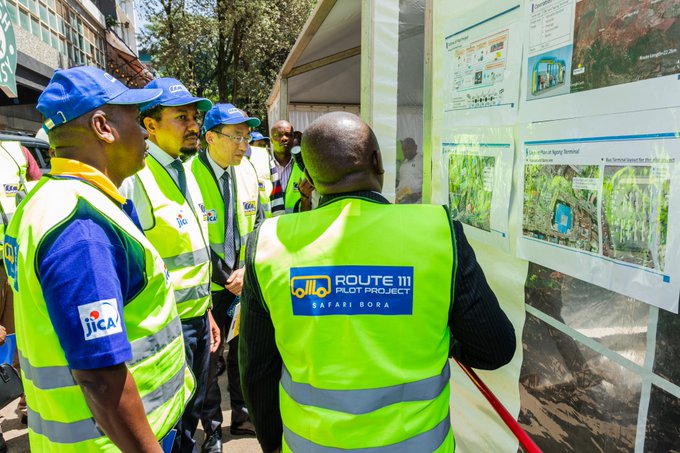NAIROBI, Kenya — Nairobi’s chaotic matatu culture is getting a sleek, European-style upgrade—and no, you don’t have to wait 30 minutes for your ride to fill up anymore.
This week, commuters got their first taste of a cleaner, more predictable public transport system as phase one of Kenya’s Bus Rapid Transit (BRT) pilot quietly rolled out on Route 111.
Think scheduled buses, fixed fares, and a future where honking minibuses and unpredictable delays might finally be replaced with order, convenience, and maybe even electric buses.
Spoiler alert: It’s not just about transport—it’s about transforming how Nairobi moves.
The Route 111 Pilot Project is a result of a strong partnership between NaMATA, @jica_direct_en @047County, @KajiadoGov, @ntsa_kenya, @NPSOfficial_KE, @KURAroads and Route 111 Bus Operators. 🧵 (1/3) — #Route111PilotProject #NaMATA #NgongRoad #SustainableTransport
Under the current pilot program, buses no longer wait to be packed like sardines before they take off. Instead, they run on set schedules, much like what you’d find in European BRT systems. For Nairobians long used to the unpredictability of matatus, it’s a seismic shift.
The Nairobi Metropolitan Area Transport Authority (NAMATA) kicked things off with the Route 111 test run between Ngong Bus Park and Pioneer Bus Station in the CBD.
Transport Principal Secretary Mohamed Daghar said the rollout reflects what’s possible when the government and industry actually collaborate.
“This project proves we can come together to ease daily transport struggles,” Daghar said.
According to stakeholders, fixed fares will offer budget certainty—no more “it’s raining, fare imepanda” surprises. Plus, commuters can now expect transparency and efficiency in their daily grind.
This pilot isn’t just a nice idea—it’s backed by big bucks. In January, Kenya secured a €320 million (Sh43.4 billion) funding deal from the European Investment Bank (EIB), French Development Agency (AFD), and the European Union (EU) to develop the Clean Core BRT Line 3.
That cash will fund a 12-kilometre stretch between Dandora and Kenyatta National Hospital (KNH) via Juja Road, with phase two extending service from Tala to Dandora and KNH to Ngong.
It’s a major move in a city where traffic congestion costs the economy billions annually.
Meanwhile, Line 5—backed by Korean Exim Bank with a Sh7.3 billion injection—is slated to run along Outer Ring Road. That 10.4-km BRT corridor will include dedicated bus lanes, electric vehicle (EV) charging stations, CCTV, and Vehicle Enforcement Systems.
Eng. James Mwaniki from NaMATA presented the Route 111 Pilot Project to the Principal Secretary, @SDoT_Kenya , Mohamed Daghar. He highlighted the project’s transformative impact on Nairobi’s public transport system. — #Route111PilotProject #YourJourneyUpgraded
However, it’s not all smooth roads—controversy flared after the Korean financier reportedly locked out non-Korean contractors from the project.
This isn’t a one-line wonder. Nairobi’s Integrated Urban Development Master Plan includes five BRT lines, each named after animals (adorable, right?). These routes are designed to streamline commuting across key corridors:
- Ndovu (Line 1): Limuru – Kitengela via Kangemi, CBD, and Imara Daima.
- Simba (Line 2): Rongai – Kenol via Bomas, Lang’ata, CBD, and Thika.
- Line 3: Dandora – KNH (currently under development).
- Line 4 & Line 5: Coming soon, with Line 5 on Outer Ring Road already partially funded and planned.
Line 2 (Simba) is about 70pc done and will roll out in two stages—starting with a Kasarani-to-KNH leg. It features 13 stations with 24 boarding platforms, and even a park-and-ride hub at Kasarani to let drivers ditch their cars and ride the BRT instead.
For a city notorious for its gridlock and unpredictable commutes, the BRT pilot represents more than just cleaner buses. It’s a shift toward a smarter, more sustainable urban lifestyle—one where time, cost, and comfort finally count for something.
Sure, we’re still early in the journey. There’s funding to manage, controversies to smooth over, and systems to build. But if Route 111 is any indication, Nairobi might just be on the fast lane to a transit transformation that sticks.





